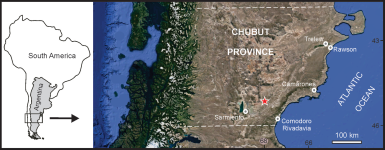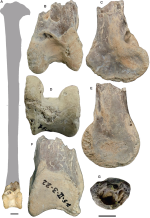Fred Ruhe
Well-known member

Carolina Acosta Hospitaleche & Washington Jones, 2024
Insights on the oldest terror bird (Aves, Phorusrhacidae) from the Eocene of Argentina
Historical Biology: An International Journal of Paleobiology.
doi:10.1080/08912963.2024.2304592
Abstract:
Phorusrhacidae, commonly known as terror birds, constitutes a group of Cariamiformes that lived mainly in South America during the Cenozoic. The oldest record is represented by an isolated distal end of tibiotarsus (MLP-PV 75-II-3-22) discovered in the Lutetian (middle Eocene) levels of the Sarmiento Formation exposed in the Cañadón Vaca locality (Chubut Province, Argentina). Despite being frequently cited as the oldest specimen of Phorusrhacidae, this specimen has never been figured or comprehensively described. Motivated by this gap and recognising the significance of this finding, we conducted a detailed comparison of the tibiotarsus MLP-PV 75-II-3-22 with those of other species, assigning it to an indeterminate species of Psilopterinae with an estimated body mass of approximately 5 kg. Furthermore, following the identification of numerous tooth marks on the distal surface, we hypothesised that this small phorusrhacid may have been subjected to an attack or scavenging event by a small-to-medium predator, such as Nemolestes spalacotherinus, a hypercarnivorous marsupial previously recorded in the Cañadón Vaca assemblage.:
Enjoy,
Fred
Insights on the oldest terror bird (Aves, Phorusrhacidae) from the Eocene of Argentina
Historical Biology: An International Journal of Paleobiology.
doi:10.1080/08912963.2024.2304592
Abstract:
Phorusrhacidae, commonly known as terror birds, constitutes a group of Cariamiformes that lived mainly in South America during the Cenozoic. The oldest record is represented by an isolated distal end of tibiotarsus (MLP-PV 75-II-3-22) discovered in the Lutetian (middle Eocene) levels of the Sarmiento Formation exposed in the Cañadón Vaca locality (Chubut Province, Argentina). Despite being frequently cited as the oldest specimen of Phorusrhacidae, this specimen has never been figured or comprehensively described. Motivated by this gap and recognising the significance of this finding, we conducted a detailed comparison of the tibiotarsus MLP-PV 75-II-3-22 with those of other species, assigning it to an indeterminate species of Psilopterinae with an estimated body mass of approximately 5 kg. Furthermore, following the identification of numerous tooth marks on the distal surface, we hypothesised that this small phorusrhacid may have been subjected to an attack or scavenging event by a small-to-medium predator, such as Nemolestes spalacotherinus, a hypercarnivorous marsupial previously recorded in the Cañadón Vaca assemblage.:
Enjoy,
Fred





